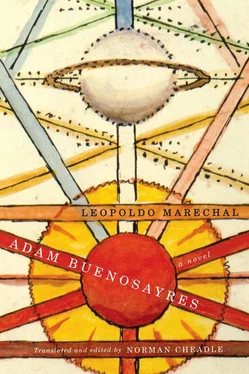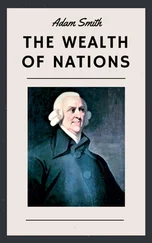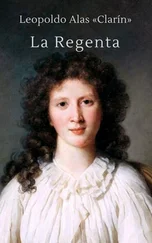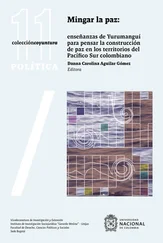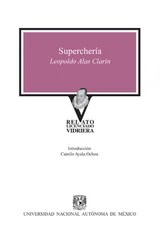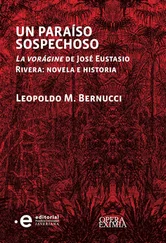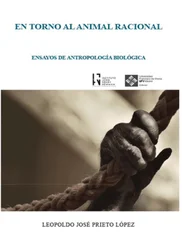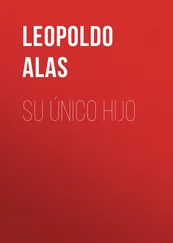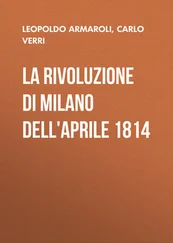30 As noted by Mansilla, gualicho means “devil” in Araucano.
31 The invented name combines the Greek morpheme paleo- , “ancient” with the Araucano term — curá , “stone.” The historical Calfucurá was for decades until his death in 1873 the most powerful Aracauno chief in Argentina.
32 Barcia (388n) notes that the image comes from Marechal’s poetry, but cites only “Didáctica de la Patria,” a poem written much later and included in Heptamerón (1966). In an earlier poem, “Gravitación del cielo” in Poemas australes (1937), the architectural metaphor is applied in a different sense to the nation’s beginnings: “¡Oh deleznable arquitectura, / oh bondadosos arquitectos! / Con tierra frágil nuestros hombres / edificaron su morada” ( OC I, 181) [O negligible architecture, / O good-hearted architects! / With fragile earth our men / built their dwelling]. It seems that the later Marechal made poetry out of his novelistic material.
33 Marechal did in fact know this man in real life. His poem “A un domador de caballos” in Poemas australes (1937) was inspired by him. Gustavo Fontán includes a short sequence with Liberato Farías in his documentary film Marechal, o la batalla de los ángeles (2002). The name of the narrator-protagonist of Marechal’s second novel, El Banquete de Severo Arcángelo (1965), is a variation on the domador ’s name: Lisandro Farías.
34 Schultz’s comment echoes the position of Leopoldo Lugones, first enunciated in his lectures on the gaucho in 1913: “[The gaucho’s] disappearance is a good thing for the country, because he contained an inferior element in his partially aboriginal blood” ( El Payador 83).
35 The last two paragraphs are a pastiche of the first Canto of “El alma del payador” [The Soul of the Payador], in Hilario Ascasubi’s poem Santos Vega (1885).
36 According to one popular version of the story, Santos el Payador (anonymous), which circulated in print in the late nineteenth century: “Santos Vega se murió. / Y fue porque lo venció / Luzbel, sin decir Jesús” (qtd. in Prieto 89) [Santos Vega died. / And it was because he was defeated by / Lucifer, without a mention of Jesus]. But in another version belonging to the oral tradition, Santos Vega met and defeated the Devil, only later to be defeated by a payador from the North (Prieto 104). Adam is championing this version.
37 This is Rafael Obligado’s version of the story in Part 4, “La muerte del payador,” of Santos Vega . As Prieto writes, this version could be, and was, read as propaganda in support of progress, or the advance of “civilization” over “barbarism,” in the terms of Sarmiento. The debate over the story is not over. In his 700-page history and anthology of gauchesque poetry, Fermín Chávez completely excludes Obligado’s poem, alleging its lack of “gauchesque spirit,” its “pessimism,” its symbolic message of “ frustración criolla ”; he prefers instead an oral version from Paraguay in which a Guaraní Santos Vega, mounted on a white horse, defeats the “infernal spirit” (Chávez 35).
38 Cocoliche was a late nineteenth-century vaudeville character who imitated the Spanish spoken by Italian immigrants and came to symbolize them, denoting as well the dialect spoken by Italian immigrants, some terms of which passed into the lunfardo argot and then later into the common language of Argentina.
39 “I came to Argentina to make America [make my fortune]. And I’m in America to make Argentina.” The chiasmic pun plays on the Italian idiomatic expression fare l’America “to make or seek one’s fortune.”
40 “I work the land. We eat bread thanks to me.”
41 The glorified or glorious body refers to the Pauline doctrine of the body’s ressurection: “[The Lord Jesus Christ] shall change our vile body, that it may be fashioned like unto his glorious body” Phillipians 3:21 ( KJV ). In medieval teaching, a saint’s corpse has the “odour of sanctity.”
42 Behind the obvious allusion to the Christian saint, Martin of Tours (316–397), lies a veiled allusion to General José de San Martín, known as the “Saint of the Sword” (cf. 634n30 and 636n1). Marechal works this poetic conflation in his later poem Canto de San Martín (1950).
43 All are birds indigenous to the Argentine pampa.
44 All traditional folk dances from various Argentine provinces.
45 The “ditch” would correspond to Medrano Creek as it passes through the farmland of Luis María Saavedra, today occupied by the soccer field of the Club Atlético Platense as well as Sarmiento Park (Piñeiro 75).
46 The Frogs , trans. Dudley Fitts (Aristophanes 93).
47 Barcia (400n) points out that the two paragraphs sung by the Chorus are full of allusions to rural Argentine folklore.
48 Navascués ( AB 241n) notes the allusion to the French expression Cherchez la femme! — that is; look for the woman of you want to get to the bottom of the matter.
49 “Yo soy la muchacha del circo, / por una moneda yo doy.” First lines of the tango “La muchacha del circo” (1928), music by Gerardo Matos Rodríguez and lyrics by Manuel Romero. The circus girl is a trapeze artist who, in exchange for a penny, shares beautiful illusions. On her precarious trapeze, she is like a white dove anxiously leaping heavenward.
50 Two popular superstitions, according to Barcia (410n). The Pig, a.k.a. the chancho de lata or Tin Pig, wears chains that rattle metallically. The Widow is a ghost who chases young lads and robs them.
51 A further send-up of the Spirit of the Earth (see 650n32).
BOOK THREE, CHAPTER 2
1 Barcia (413n) explains the process: an enclosure or pond of mud would be made; horses would be sent in to work the mud with their hooves and then haul it out for making bricks.
2 In the original: “¡Traga santos y caga diablos!” [Swallow saints and shit devils!], meaning that they present a sweet image but their words or actions belie the appearance.
3 Villa Urquiza: a barrio in Buenos Aires bordering on Saavedra.
4 Emilio Salgari (1862–1911), Italian author of adventure novels, especially the pirate stories whose protagonist was Sandokan.
5 During La Semana Trágica [The Tragic Week] in January 1919, a series of strikes inspired by Anarchists and Communists were brutally repressed by the Argentine Federal Police and the National Army with the help of paramilitary groups, leaving hundreds dead and thousands wounded. The violence of the repression got out of control and spilled over into attacks on Jewish establishments.
6 La Brecha . No such daily seems to have existed but it is a likely name for an anarchist publication. The phrase abrir brecha means “to break through”; firme en la brecha “to stand firm” was a militant watchword. Chilean author Mercedes Valdivieso titled her 1961 feminist novel La brecha . In Montevideo, Brecha has been a left-wing weekly since 1985, when it succeeded its forerunner, Marcha , shut down by the Uruguayan dictatorship in 1974.
7 The issue of cremation was indeed controversial. Roberto Arlt was cremated at his death in 1942, in accord with his express wish. But Arlt’s friend and mentor, the Boedo writer Elías Castelnuovo (1893–1982), regretfully recalls visiting with Arlt the crematorium at the Chacarita Cemetery where the director, a medical hygienist and “fervent believer” in cremation, convinced Arlt with “catechizing propaganda” to sign up for cremation upon his death (qtd. in Saítta 297). Castelnuovo, a progressive socialist intellectual, apparently harbours the same cultural conservatism implied by Marechal’s satirical treatment of Zanetti.
Читать дальше
